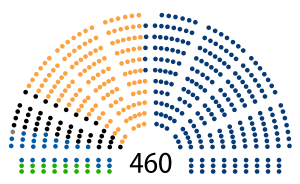Sejm of the Republic of Poland
|
Sejm of the Republic of Poland Sejm Rzeczypospolitej Polskiej |
|
|---|---|
| 8th term | |
 |
|
| Type | |
| Type |
Lower house of the Parliament of Poland
|
| History | |
| Founded | 1493 |
| Leadership | |
|
Joachim Brudziński, PiS
Barbara Dolniak, .N Małgorzata Kidawa-Błońska, PO Ryszard Terlecki, PiS Stanisław Tyszka, K’15 Since 12 November 2015 |
|
| Structure | |
 |
|
|
Political groups
|
Government party (234)
Opposition (226)
|
| Elections | |
|
Last election
|
October 2015 |
|
Next election
|
Not later than November 2019 |
| Meeting place | |
 |
|
| The Sejm Building Śródmieście, Warsaw |
|
| Website | |
| sejm |
|
| Footnotes | |
| a 8% for coalitions. | |
Government party (234)
Opposition (226)
The Sejm of the Republic of Poland ([sɛjm]; Polish: Sejm Rzeczypospolitej Polskiej) is the lower house of the Polish parliament. It consists of 460 deputies (posłowie, literally "envoys", in Polish) elected by universal ballot and is presided over by a speaker called the "Marshal of the Sejm of the Republic of Poland" (Marszałek Sejmu Rzeczypospolitej Polskiej). In the Kingdom of Poland, "Sejm" referred to the entire three-chamber parliament of Poland, comprising the lower house (the Chamber of Envoys; Polish: Izba Poselska), the upper house (the Senate; Polish: Senat) and the King. It was thus a three-estate parliament. Since the Second Polish Republic (1918–1939), "Sejm" has referred only to the lower house of the parliament; the upper house is called the Senat Rzeczypospolitej Polskiej ("Senate of the Republic of Poland").
"Sejm" stems from an Old Slavic word meaning "gathering". Its origin was the King's Councils (wiece), which gained power during the time of Poland's fragmentation (1146–1295). The Sejm in Łęczyca was the most notable of these councils, in that for the first time in Poland's history it established laws constraining the power of the ruler. It forbade arbitrary sequestration of supplies in the countryside and takeover of bishopric lands after the death of a bishop. These early Sejms were not a regular event, they convened at the King's behest. After the 1493 Sejm in Piotrków, it became a regularly convening body, to which indirect elections were held every two years. The bicameral system was also established there. The Sejm now comprised two chambers: the Senat (Senate) of 81 bishops and other dignitaries; and the Chamber of Envoys, made up of 54 envoys elected by smaller local sejmik (assemblies of landed nobility) in each of the Kingdom's provinces. At the time, Poland's nobility, which accounted for around 10% of the state's population (then the highest amount in Europe), was becoming particularly influential, and with the eventual development of the Golden Liberty, the Sejm's powers increased dramatically.
...
Wikipedia
